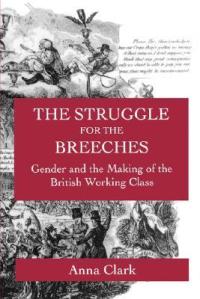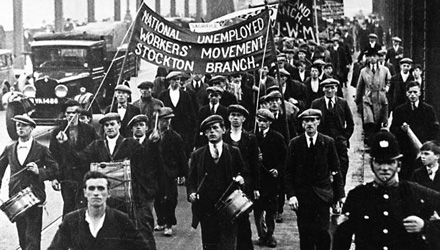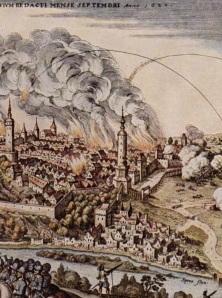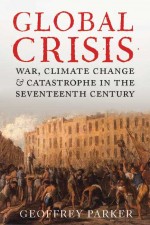Robert Stearn is a PhD candidate in English and Humanities at Birkbeck. He is interested in relations between skill, gender, and forms of writing in late 17th- and early 18th-century Britain and also in the uses of skill in contemporary welfare policy.
Worries about the end of labour history framed this panel, but Brady, Rose, and Levine-Clark were skeptical about the need for them. Their papers explored the kinds of scholarship currently pursuing what might once have been called labour history: increasing in specificity with each speaker –from Brady’s exploration paper of the place of class within historical inquiry, to Rose’s review of the present situation of gender and labour history, to Levine-Clark’s analysis of the interplay of working class masculinities, welfare policy, and cultures of work in the 1920s –each proffered some answers to the question of whether class has disappeared from historians’rubrics (and if so why), or has simply been reconfigured in useful ways and dispersed across new branches of the writing of history.
Sean Brady began on ground also covered by Stedman Jones and Elliot, setting out the fortunes of the British Marxist historians’combination of history and Marxist economics. Their collective efforts, Brady argued, resulted in the production of a new framework for the study of history, with the agency of working people at its centre. But over the last 30 years, the categories that labour history seemed to depend on –labour, class, and work –have undergone development and crises. Historians from the medieval to the modern have questioned whether class ever meant what some of its first investigators thought it meant. The criticisms are well-known: that the coherence imposed by historians of industrialisation on the concept of the working class and the mass of people identified with it reflected a temporarily unifying but falsely homogenising fiction; that women were completely neglected as members of classes, and gender neglected as a category structuring both experience and patterns of exploitation, with the power to disaggregate identities and disrupt gender-blind theories of capitalism and class; that only limited consideration was ever given to the discourses used by groups to map out the common projects that constituted them as classes and mobilised them politically, or by means of which groups excluded from their membership –in the name of a uniform class subject –particular persons or attributes.
So, Brady asked: is this why labour history as a recognisable sub-discipline of historical scholarship seems to be in retreat, at least in Europe and North America?Is labour history insular, ‘flabby’, outmoded by the cultural turn; or are factors external to the discipline more important–like European and North American deindustrialisation and the concomitant decline of organised labour movements? (This interpretation was also offered by Geoff Eley during questions, while Alan Knight pointed to what he saw as the Anglocentric bias of the problems posed by the panel: labour history of Latin America, he said, is a vigorous, discipline –perhaps because there is still a substantial amount of industrial production in many Latin American countries.)
 Sonya Rose answered Brady’s question by arguing that in fact, the history of gender and labour flourished in the 1990s –well after the date scholars of gender and sexuality are supposed by some to have abandoned class for intersectionality. She pointed to analysis of the gendering of the labour force, of cultures of work, and of notions of skill and skill levels and the value of labour, to be found in works like Laura Downs’Manufacturing Inequality,or Anna Clark’s The Struggle for the Breeches: Gender and the Making of the British Working Class(both from 1995). For Rose, these authors’attentiveness to the ways in which labour are class are gendered and racialised –combined with the work of Selina Todd, Caroline Bressey, Carolyn Steedman, and others –collectively suggests two things: first, the centrality of (domestic) service work in working class history; and secondly, that taking the gendered and classed nature of work together allows us to see new ways in which conflict between worker and employer, labour and capital, might be a motor of historical change: both masculinity and femininity are seen to be imbricated with cultures of work (albeit not symmetrically), and to be in need of investigation. In office work, for example: when women enter this route to a particular gendered middle class identity, they are seen as workers whose presence degrades others; they prompt men to professionalise their work (they are clerks not copyists), in order to maintain status, autonomy, and ‘gendered self-respect’.
Sonya Rose answered Brady’s question by arguing that in fact, the history of gender and labour flourished in the 1990s –well after the date scholars of gender and sexuality are supposed by some to have abandoned class for intersectionality. She pointed to analysis of the gendering of the labour force, of cultures of work, and of notions of skill and skill levels and the value of labour, to be found in works like Laura Downs’Manufacturing Inequality,or Anna Clark’s The Struggle for the Breeches: Gender and the Making of the British Working Class(both from 1995). For Rose, these authors’attentiveness to the ways in which labour are class are gendered and racialised –combined with the work of Selina Todd, Caroline Bressey, Carolyn Steedman, and others –collectively suggests two things: first, the centrality of (domestic) service work in working class history; and secondly, that taking the gendered and classed nature of work together allows us to see new ways in which conflict between worker and employer, labour and capital, might be a motor of historical change: both masculinity and femininity are seen to be imbricated with cultures of work (albeit not symmetrically), and to be in need of investigation. In office work, for example: when women enter this route to a particular gendered middle class identity, they are seen as workers whose presence degrades others; they prompt men to professionalise their work (they are clerks not copyists), in order to maintain status, autonomy, and ‘gendered self-respect’.
But is this labour history? Considerable pressure is put on the categories labour, class, and work if we want to say it is, Rose argued. It’s not clear how office work fits in to traditional labour history, unless we want to think about class as a means of access to kinds of economic and social privilege –as ‘structured differences in life chances’that are given particular meanings and offer opportunities for distinction (in Bourdieu’s sense). And if that’s one thing class is, what is work? Rose suggested we ought to adopt a capacious definition: the ‘purposeful application of mental and physical forces to fulfil needs’. (Contrast, for example, AndréGorz’s insistence that work is not the repeated activity people have to do to maintain themselves, their families, or their surroundings, but only ‘an activity in the publicsphere, demanded, defined, and recognised as useful by other people’.[1]) And then what about exploitation? The question was as central to E. P. Thompson’s work as it was to Marx’s, Rose acknowledged, and ended her paper by suggesting that an answer to this question might be found in the profession’s turn to world history (which itself encourages a capacious understanding of what class and work might be). For Rose, the household emerges as the best unit of analysis in global labour history, and an investigation into the survival strategies of those composing it –their struggles for security and autonomy –the best way that historical inquiry might proceed.
Marjorie Levine-Clark concentrated on the connection between ‘structural insecurity’(in Rose’s words) and gender: the undoing of masculinity by unemployment among men who shared constraints and opportunities as a result of their economic situation and the specifics of the poor relief policies that impacted them in late Victorian and early twentieth-century Britain. Suggesting that her paper be viewed as a contribution to Rose’s suggested new histories of class formation –which ‘would be used to explore the lives of the unorganised, the unemployed, and the underemployed[2]–Levine-Clark began in September 1921, when Labour MP James Wilson addressed a crowd of unemployed men in Dudley, telling them they were ‘not loafers, but men’: men who would demand the removal of their unemployment via ‘useful and productive schemes’. To cherish the feelings of injured manhood that followed their loss of work, Wilson told them, and to let their wives and children go hungry if, out of pride, they refused to ask local authorities for assistance, would make them worse than cowards.
 For Wilson, men were people who wanted to work and preferred work to the dole. These men, if unemployed, were the honest poor (‘honest’when applied to women, Levine-Clark pointed out, retained a primarily sexual meaning). They were men who could demonstrate that they possessed the ‘work imperative’(desire to labour) and ‘family liability’: men with wives and children were allowed to work more than men without, and the greater the number of his children, the more work a man was allowed to do; married men would also have an easier time convincing authorities that their search for work was genuine. At the same time, while the system did in principle recognise the possibility of women being unemployed, a women’s wages were not counted in order to disqualify a man from receipt of welfare, although the reverse was the case (this changed with the introduction of means testing in the 1930s).
For Wilson, men were people who wanted to work and preferred work to the dole. These men, if unemployed, were the honest poor (‘honest’when applied to women, Levine-Clark pointed out, retained a primarily sexual meaning). They were men who could demonstrate that they possessed the ‘work imperative’(desire to labour) and ‘family liability’: men with wives and children were allowed to work more than men without, and the greater the number of his children, the more work a man was allowed to do; married men would also have an easier time convincing authorities that their search for work was genuine. At the same time, while the system did in principle recognise the possibility of women being unemployed, a women’s wages were not counted in order to disqualify a man from receipt of welfare, although the reverse was the case (this changed with the introduction of means testing in the 1930s).
These methods of allocation were not only, Levine-Clark stressed, a privilege foisted upon working-class men by the dictates of policy: working men’s organisations, she argued, themselves promoted a model of masculinity based upon the household and men’s ability to support a family, so effacing the needs of single men and promoting an unrealistic notion of the family wage. The same organisations cemented the centrality of employment to masculinity when they argued that men’s striking was legitimate because it was an instance of their refusal to work in an environment that unmanned and demeaned them; of their being not loafers but citizens –according to a particular gendered conception –demanding what was their right. Unskilled and unmarried men, then, could not be honestly poor: more than the apparently lesser need they had for relief, their gender nonconformity (lack of family liability) and occupational status made it impossible for them to demonstrate possession of the work imperative and rendered them ineligible. The early national insurance system was in this sense, Levine-Clark concluded, both heteronormative and patriarchal, in a manner specific to the social and economic conditions of the time to which it responded.
Nonetheless, lineaments of these early twentieth-century approaches are visible in contemporary welfare policy. If the late nineteenth century saw the development of arguments that unemployment was a problem for macroeconomics, rather than an individual moral failing, these perspectives were never completely taken up by political elites –as Levine-Clark noted, citing recent comments by Iain Duncan Smith in the UK and Paul Ryan in the US as evidence that the struggle to ‘separate structural and moral’registers of unemployment had not been won. The insecurity of honest poverty (by definition one could never be honestly poor for very long) remains a powerful ground of reactionary appeal even in our present moment, in which, absent a codified separation between paupers and citizens, we ostensibly understand the provision of social security as a right attached to citizenship, rather than an alternative to it.
Perhaps the stubborn retention of these concerns in public policy –the considerable restructuring of the British economy since the 1920s notwithstanding –suggests a new direction for history and politics. As Catherine Hall asked, in reply to Knight and others’questions: ought historians to be so concerned to make subdivisions of history writing live forever, if the concerns that were addressed by labour history are now addressed more capaciously, in concert with diverse modes of inquiry which transform them, by historians in a variety of fields of scholarship with no desire to call themselves labour historians?
[1]AndréGorz, Critique of Economic Reason (London and New York: Verso, 1989), p. 13.
[2] Sonya Rose, ‘Resuscitating Class’, Social Science History, 22.1 (1998), 19-27 (20).










You must be logged in to post a comment.